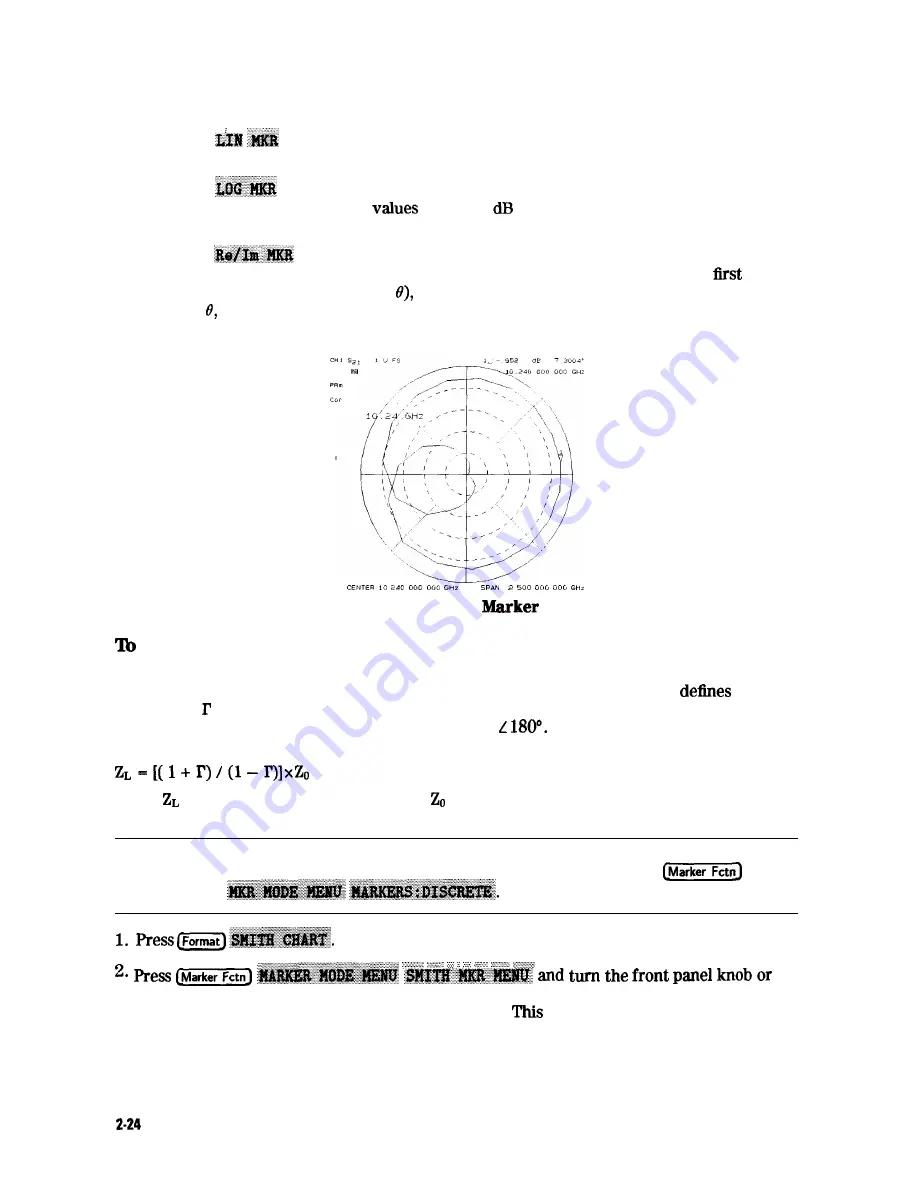
2. Select the type of polar marker you want from the following choices:
n
Choose
if you want to view the magnitude and the phase of the active marker.
The magnitude values appear in units and the phase values appear in degrees.
n
Choose
if you want to view the logarithmic magnitude and the phase of the
active marker. The magnitude
appear in and the phase values appear in
degrees.
n
Choose
if you want to view the real and imaginary pair, where the complex
data is separated into its real part and imaginary part. The analyzer shows the
marker value the real part (M cos and the second value is the imaginary part
(M sin where M=magnitude).
Figure 2-16. Example of a Log
in Polar Format
Use Smith Chart Markers
The amount of power reflected from a device is directly related to the impedance of the device
and the measuring system. Each value of the reflection coefficient (I’) uniquely
a device
impedance; = 0 only occurs when the device and analyzer impedance are exactly the same.
The reflection coefficient for a short circuit is: I’ = 1
Every other value for I’ also
corresponds uniquely to a complex device impedance, according to the equation:
where is your test device impedance and is the measuring system’s characteristic
impedance.
Note
For greater accuracy when using markers in the Smith chart format, it
is recommended to activate the discrete marker mode. Press
enter a value from the front panel keypad to read the resistive and reactive components of
the complex impedance at any point along
the
trace.
is the default Smith chart marker.
The marker annotation tells that the complex impedance is capacitive in the bottom half of
the Smith chart display and is inductive in the top half of the display.
Making Measurements
Summary of Contents for 8719D
Page 153: ...M a k i n g M i x e r M e a s u r e m e n t s O p t i o n 089 Only1 3 19 ...
Page 189: ... 4 18 Printing Plotting and Saving Measurement Results ...
Page 338: ... Figure 6 41 Open Circuit Rmnination 6 64 Application and Operation Concepts ...
Page 467: ......
Page 468: ...8 2 Menu M a p s ...
Page 469: ......
Page 470: ...84 Menu Maps ...
Page 473: ...Menu Maps 8 7 ...
Page 475: ...Menu Maps a 9 ...
Page 476: ...I 9 10 MenuYaps ...
Page 477: ...Menu Maps 9 11 ...
Page 478: ...MlFl EF FEFEFEII TE 9 l 2 Menu Maps ...
Page 479: ......
Page 480: ...8 14 Menu Maps ...
Page 481: ...r c 1 pb6le Menu Maps 8 l 6 ...
Page 537: ...6 66 Key Definitions ...
Page 556: ... Ihble 9 2 Softkey Locations continued Softkey Front Panel Access Key Key Definitions 9 75 ...
Page 557: ...9 76 Key Definitions ...
Page 558: ...lhble 9 2 Softkey Locations continued Softkey Front Panel Access Key Key Definitions D 77 ...
Page 559: ...Ihble 9 2 Softkey Locations continued Softkey Key Definitions ...
Page 560: ... Jhble 9 2 Softkey Locations continued Key Definitions a 78 ...
Page 561: ...able 9 2 Softkey Locations continued 8 80 Key Definitions ...
Page 563: ... ble 9 2 Softkey Locations continued 842 Definitions ...
Page 565: ...able 9 2 Softkey Locations continued Softkey Front Panel Access Key 8 64 Key Definitions ...
Page 566: ... Ihble 9 2 Softkey Locations continued Key Definitions 8 85 ...
Page 567: ...Kay Definitions ...
Page 568: ... lbble 9 2 Softkey Locations continued Key Definitions 8 87 ...
Page 569: ...lhble 9 2 Softkey Locations continued Softkey Front Panel Access Key 8 88 KeyDefinitions ...
Page 570: ... able 9 2 Softkey Locations continued Softkey Front Panel Access Key Key Definitions 8 88 ...
Page 571: ...840 Key Definitions Ihble 9 2 Softkey Locations continued Softkey Front Panel Access Key ...
Page 572: ...able 9 2 Softkey Locations continued Softkey Front Panel Key Definitions 8 81 ...
Page 573: ... Ihble 9 2 Softkey Locations continued Softkey Front Panel Access Key 842 Key Definitions ...






























